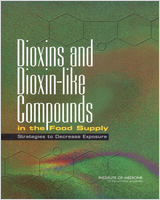NCBI Bookshelf. A service of the National Library of Medicine, National Institutes of Health.
Institute of Medicine (US) Committee on the Implications of Dioxin in the Food Supply. Dioxins and Dioxin-like Compounds in the Food Supply: Strategies to Decrease Exposure. Washington (DC): National Academies Press (US); 2003.

Dioxins and Dioxin-like Compounds in the Food Supply: Strategies to Decrease Exposure.
Show detailsDioxin and dioxin-like compounds, or DLCs, are found throughout the environment: in soil, water sediments, and air. Exposure to these unintentional contaminants occurs largely through the food supply, although at low levels. Even though DLC levels in the environment and in foods have been declining over the past several decades, public concern persists because DLCs are widespread, and there remains a great deal of uncertainty about their potential adverse health effects. There is additional concern regarding the potential impact of exposure on the population groups that are particularly sensitive to exposure to toxic compounds (e.g., developing infants) and those that are more highly exposed than the general population (e.g., breastfeeding infants and groups for whom fish and wild game are important subsistence or cultural food sources).
Against the background of increasing knowledge about potential public health effects of dioxins in the food supply, the National Science and Technology Council's Interagency Working Group (IWG) on Dioxin recognized the need for an independent group to examine the scientific evidence of the impact of the presence of dioxins and related compounds in the food supply on food safety and to assess options to reduce exposure to dioxins through foods that would maintain optimal health and nutritional status for the population. IWG, with support from the U.S. Department of Agriculture, the U.S. Department of Health and Human Services, and other agencies and sponsors, asked the National Academies to explore these issues. Thus, the Institute of Medicine, in consultation with the National Research Council, convened a committee with a diverse background and a broad scope of expertise to address the task put to them by the sponsors.
The committee was charged to review the scientific evidence to identify potential ways to reduce the level of DLCs in foods. Importantly, the committee was instructed to consider the need to protect the public and to assess the potential impact of its recommendations to food and nutrition policies, particularly public education and food assistance programs.
The study sponsors recognized that data limitations would allow only qualitative estimates of net risk, descriptions of exposure reduction, and identification of data needs. In response, the committee offered the sponsoring agencies an array of options to reduce DLC exposure through foods while gathering the data needed to determine future action. These options should also be of use to stake-holders in the agricultural and food-processing industries and to public health professionals.
The final recommendations are selected from the array of options and reflect the committee's conclusion that, because uncertainties exist, the level of risk must be determined with greater certainty before regulatory action can be taken, and that it is in the public's best interest for the government to develop a strategic action plan that includes interim steps to reduce exposure as long as the steps do not lead to undesirable consequences to human health and do not impinge unduly upon the cultural norms of the population.
ACKNOWLEDGMENTS
The Committee on the Implications of Dioxin in the Food Supply was aided in its challenging tasks by the invaluable contributions of a number of individuals. First and foremost, many thanks are due to the committee members who volunteered countless hours to the research, deliberations, and preparation of the report. Their dedication to this project and to a stringent timeline was commendable and was the basis of our success.
Many individuals volunteered significant time and effort to address and educate our committee members during the workshops, and the committee thanks them. The committee wishes to acknowledge the invaluable contributions of the FNB study staff, Ann Yaktine, study director; Tazima Davis, research assistant; and Sanait Tesfagiorgis and Sybil Boggis, senior project assistants. The committee is grateful for the contributions of Tina Rouse and Abigail Mitchell, program officers. Special thanks also to Roberta Wedge, senior program officer, and Jamie Jonker, program officer, for their helpful review and suggestions. The committee also thanks Geraldine Kennedo for logistical arrangements, Marcia Lewis for drawing the chemical structures, and Gail Spears for technical editing. This project benefited from the general guidance of Allison Yates, director, and Linda Meyers, deputy director, of the Food and Nutrition Board.
ROBERT S. LAWRENCE, Chair
Committee on the Implications of Dioxin in the Food Supply
- Preface - Dioxins and Dioxin-like Compounds in the Food SupplyPreface - Dioxins and Dioxin-like Compounds in the Food Supply
- Nepenthes MicrobiotaNepenthes MicrobiotaDiet determines bacterial diversity and community structure in Bornean pitcher plantsBioProject
Your browsing activity is empty.
Activity recording is turned off.
See more...